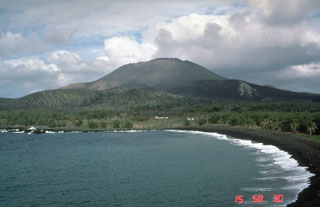Report on Pagan (United States) — 27 October-2 November 2010
Smithsonian Institution / US Geological Survey
Weekly Volcanic Activity Report, 27 October-2 November 2010
Managing Editor: Sally Sennert.
Please cite this report as:
Global Volcanism Program, 2010. Report on Pagan (United States) (Sennert, S, ed.). Weekly Volcanic Activity Report, 27 October-2 November 2010. Smithsonian Institution and US Geological Survey.
Pagan
United States
18.13°N, 145.8°E; summit elev. 570 m
All times are local (unless otherwise noted)
Low-level gas-and-steam plumes from Pagan were observed in satellite imagery during 24 and 26-27 October. The Aviation Color Code remained at Yellow and the Volcano Alert Level remained at Advisory. Pagan is not monitored with ground-based geophysical instrumentation; the only source of information is satellite observation and occasional reports from observers who visit the island.
Geological Summary. Pagan Island, the largest and one of the most active of the Mariana Islands volcanoes, consists of two stratovolcanoes connected by a narrow isthmus. Both North and South Pagan stratovolcanoes were constructed within calderas, 7 and 4 km in diameter, respectively. North Pagan at the NE end of the island rises above the flat floor of the northern caldera, which may have formed less than 1,000 years ago. South Pagan is a stratovolcano with an elongated summit containing four distinct craters. Almost all of the recorded eruptions, which date back to the 17th century, have originated from North Pagan. The largest eruption during historical time took place in 1981 and prompted the evacuation of the sparsely populated island.

